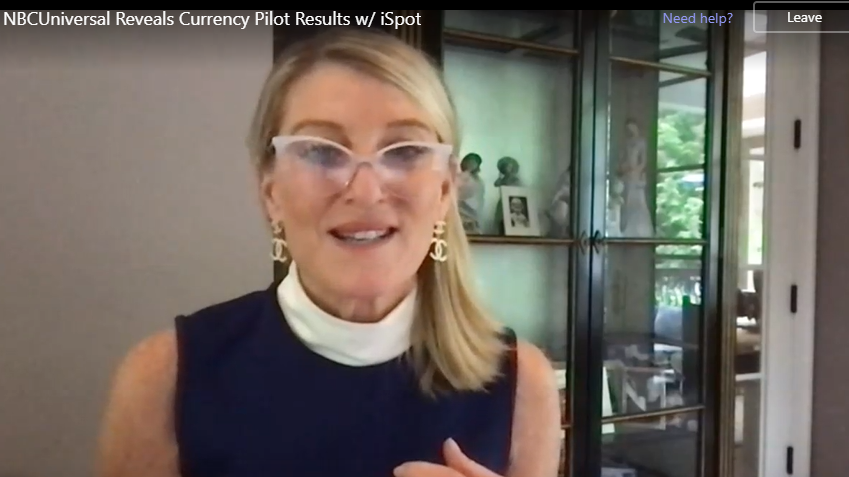NBCU Says 30%-40% of Campaigns Should Be OTT, Based on iSpot Test Data
About 40% of upfront deals employ non-traditional guarantees, NBCU’s Laura Molen says

NBCUniversal says that 30% to 40% of TV ad campaign’s impressions should come from over-the-top streaming in order to optimize results, based on its recent test with advertisers using data from iSpot.tv.
Laura Molen, president of advertising sales and partnerships at NBCU, said that about 40% of the company’s upfront deals were done based on something other than the traditional age and sex guarantees, using NBCU’s own AdSmart audience based system, OpenAP, iSpot, or Nielsen.
“We are already living in a multi-currency future,” Molen said during a presentation that laid out the results of a test-and-learn NBCU conducted with 67 advertisers and iSpot, which was selected as NBCU’s first certified partner for cross-platform measurement.
iSpot is one of the companies looking to challenge Nielsen, long the leader in the TV audience measurement business. For decades Nielsen data was the currency used to buy and sell data, but NBCU and other media companies are looking for alternatives as the media environment gets more complicated.
The test proved that with iSpot’s data “we can help them optimize their campaigns and get the results they expect from our premium content, including the best overall campaign reach and the right frequency,” she said. “This cross-platform currency is ready to transact today, right now and new currencies are here to stay.”
Kelly Abcarian, executive VP of measurement and impact at NBCU, who has led NBCU’s efforts to find more up-to-date audience measurement systems, said that during the test it found that just 9% of the advertisers’ impressions were coming from OTT, compared to 91% from linear broadcast and cable networks.
That’s way too low, according to the test, which determined that in order to optimize reach and frequency campaigns should have between 30% and 40% of their impressions coming from OTT.
Broadcasting & Cable Newsletter
The smarter way to stay on top of broadcasting and cable industry. Sign up below
Abcarian said there were two main reasons why brands were not buying as much OTT as they should.
One was because current measurement systems don’t unify linear and OTT at scale. The second is because advertisers don’t have the confidence that adding OTT won’t just increase frequency.
“Our test and learn proved how we can do just that,” Abcarian said.
The test also showed that NBC's streaming properties “truly deliver on the promise of helping our advertisers find audiences they can't reach with us on linear, making Peacock a critical part of their overall campaign plan,” she said. NBCU said that 64% of the impressions delivered by Peacock went to a streaming-only audience.
During the test and learn, NBCU and iSpot found that advertisers fell into four categories when it came to how they employed streaming media and OTT.
There were beginners with less than 10% of their impressions in OTT, experimenters with 10% to 20% in OTT, adventurers with 20% to 30%, and pioneers at 30% plus.
“What we found was that brands with a much richer OTT mix did better. [They then] had higher overall reach with acceptable frequency levels,” she said. “And getting data in 48 hours was fast enough to optimize in flight to drive better ad effectiveness. That’s not only a game changer, we believe it will make a material impact on helping our clients deliver on ROI.”
Not all clients need the same level of OTT investment, she noted. For example an advertiser looking to reach a younger audience would need more OTT in their campaign.
Sean Muller, CEO of iSpot, reviewed a case study involving a larger retailer whose ad mix started out with a very low level of OTT spending. When it increased OTT impressions to 7% of its mix, additional reach was generated while frequency stayed low. “In other words, these tended to be lighter linear viewers,” Muller said. Muller earlier, in a keynote at the Advanced Advertising Summit in Los Angeles, cited the 30%-40% optimum target, saying many advertisers were underspending on OTT.
Muller compared the retailer to another brand that was in the pioneer category. The pioneer brand ran 38% fewer impressions, but because its OTT mix was at 33%, its reach was higher and its frequency was 66% lower.
Molen concluded that the time to transition to new currencies was now.
“We’re offering resources, funding manpower and experts to our partners to help ease the transition to new currencies,” she said. ■
Jon has been business editor of Broadcasting+Cable since 2010. He focuses on revenue-generating activities, including advertising and distribution, as well as executive intrigue and merger and acquisition activity. Just about any story is fair game, if a dollar sign can make its way into the article. Before B+C, Jon covered the industry for TVWeek, Cable World, Electronic Media, Advertising Age and The New York Post. A native New Yorker, Jon is hiding in plain sight in the suburbs of Chicago.

